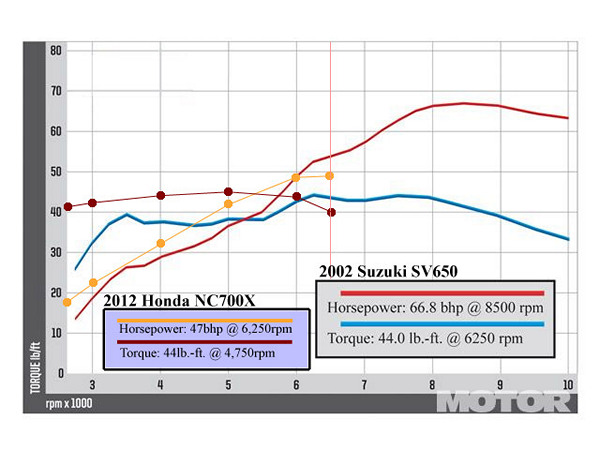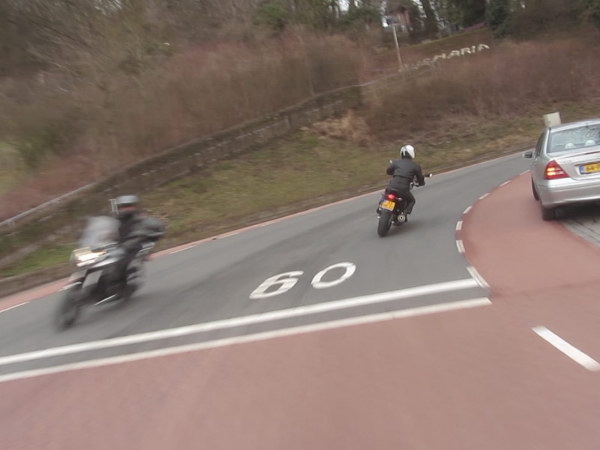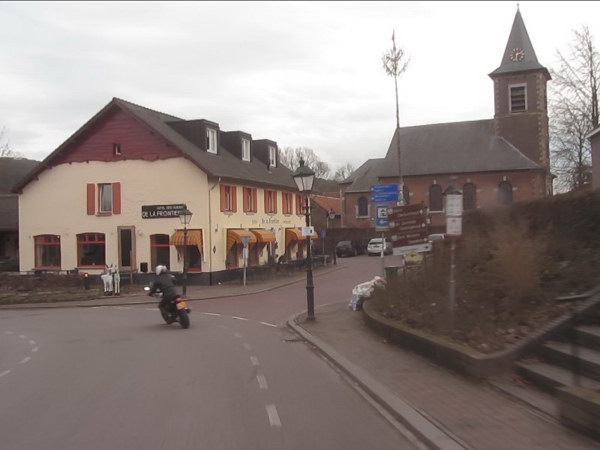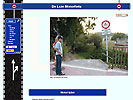A ride report of the Honda NC700X en NC700S, in which we pay extra attention to those properties that are important for a beginning motorcycle rider, and for those who didn't ride for years and start riding again.
This Honda is a very pratical, pleasant, common-sense, no-nonsense bike, on which everyone will feel at home immediately.
![]() Er is een Nederlandse versie:
Er is een Nederlandse versie:
https://www.luiemotorfiets.nl/motoren/NC700/
The NC700S and NC700X
New Commuter?
The "no-nonsense" bikes of Honda have been called CB for a long time, CB standing for Commuter Bike. We didn't find the meaning of "NC", but in our opinion, it should mean New Commuter. For the NC700 (in both variants) is a very practical motorbike, suitable for almost everything, and especially for communting.
Car engine
The twin engine of the NC700 is completely new, and it is based on a car engine. This fact predicts a very long life, and it explains the torque that is available from very low revs, and the extremely predictable behaviour.
The bike is, as we will show, suitable for a beginner or someone who starts riding again after a long time, but it's definitely a good bike for others as well: it is a motorcycle that you can use for commuting, holidays, touring or fetching groceries. It's a motorcycle for everyone.
X and S
The S-version is the naked bike of the two. The X-version has somewhat longer suspension travel, and a small beak which gives the impression of an adventurer.
We could have a test ride through Hensgens Maastricht.
Seat height
Seat height NC700S
The seat height of the NC700S (the naked version) is 79cm. The seat is not wide, which together with the low height ensures that I (169 cm tall, relatively short legs) can easily flatfoot the ground while seated. Of course, that's handy, and gives you the feeling of an easily to control bike.
Seat height NC700X
The NC700X (the adventure-version) is slightly higher: 81.6cm. For me this means that I can't flatfoot, but my feet can touch the ground easily with the front halves of them. This is sufficient to control the bike.
Center of gravity
On top of the low seat heights comes the fact that the center of gravity is very low.
The seat height and the low center of gravity are both aspects that contribute to the fact that you feel at home immediately on these bikes.
Position
The seating position is fairly straight up; on the NC700X slightly more so than on the NC700S. Your knees are bent rather sharply. I like that, but others might want the steps a bit more to the front.
The dashboard and the mirrors
Dashboard
The dashboard is completely digital. In the middle, you see your speed in big figures. To the right, you see horizontal stripes indicating how full the tank is.
To the left is a clock and a trip counter. On top, you see the control lights.
The figures from 0 until 8 are for the rpm (you have to multiply by 1000). While riding, you will see an indication of the rpm in that area.
One of the colored light is a green N, of neutral. While riding, it will tell you which gear you are using.
Mirrors with five corners
It might take a bit of time for who is used to round mirrors, these pentagonal mirrors.
But they are made for optimal view at the spot which is important.
I you try to imagine how big a round mirror would have to be to offer the same view where it matters, you realise that this is a clever design.
Theye are easily adjustable. So your view to what's behind your back is excellent.
The place of the tank
Storage compartment
On the spot where you will normally find the tank, the NC700X and S have a storage compartment. It is big enough to contain your helmet.
So with these bikes, there is no need to take a top case, a tankbag or a rucksack: to bring your heavy chain-lock or whatever you want to take with you to work, you simply put it in the storage compartment, and at work you can replace it with your helmet.
Lock
The lock for this storage compartment is near the ignition, but then on the other side of the handlebars. (you see the key sticking out). The ignition itself is also clearly visible on this photo. It is placed where you expect it.
Tank under the buddyseat
The gas tank is placed under the buddyseat. With the same lock that unlocks the storage compartment, you can flip open the buddyseat.
Under the buddyseat you find the cap of the gas tank.
In the middle
There are more motorcycle with the gas tank placed there, and often, you have to fill the bike from the side in such cases. That is a nuisance, because you have to take care at a gas station to find a spot at the right side of a pump.
The NC700 doesn't have that disadvantage: you can easily fill the tank from both sides.
Spill
Another advantage of this construction is that you will never spill gas over the paint of your tank: when you spill gas, it will be collected in a kind of cup around the cap, which enables you to swipe it clean easily.
Content and range
The tank holds 14,1 litre. It doesn't seem that much, but the NC700S and X come far with that amout of fuel (according to Honda the NC700X rides 27,9 kilometers on a litre and the S 27,7).
So the range is almost 400 kilometers.
Version with an automatic gearbox
Automatic gearbox
Both versions have an option for an automatic gearbox (you can get them "foot-geared" as well, of course)
This automatic gearbox has the special property that you can also shift gears by hand. There is even a mode in which you only shift by hand.
Switch the automatic gearbox off and on
On this photograph you can just see the switch with which you can choose between the automatic gearbox or shifting by hand: behind the kill switch, at the origin of the brake handle.
Modi
With a switch at this side of the kill switch, you can choose between "sport", normal or neutral for the automatic gearbox.
The sport modus keeps the revs a bit higher; the normal modus is enough in most circumstances.
Litterally hand-shifted
With the non-automatic gearbox, you shift - of course - with your foot; but when you shift manually on the automatic gearbox-version, you shift litterally with your (left) hand.
Buttons on the handlebar
Below, under the switch for the blinkers, you can see the button with which you can downshift. You can, obviously, downshift in this way when you have set the bike on manual shifting, but you can also use this button when you are using autmatic shifting: you can always, at any time, overrule the automatic gearbox.
The button for shifting up is at the back, at the same height (so you can't see it here).
Getting used
It will take a while before you've got used to manual shifting with this automatic gearbox (if only for the absence of a clutch handle), but after a while, you will notice that t is a relaxing way of riding. It appears that you get used very easily to manually shifting with your left hand if you would choose another gear than the automatic gearbox.
Especially being able to shift down before a corner is ideal: then it's easy to ride through the corner without having to brake first.
Hand brake
Because the automatic-version cannot be parked in gear, this version has a real hand brake.
You control the handbrake with the black handle, that you see left of the mirror on this photo.
Shift up
Also visible on this photo is the button for up-shifting: the light grey button, right below the mirror.
Starting and riding
Low revs
Time to ride!
Directly from the start, you will notice that the NC700 runs very smoothly, from the very low revs.
When you have to ride a U-turn, or have to manouvre out of a tight parking space, this is a big advantage: even when your speed is almost zero, you don't need to pull the clutch. Even in first gear, the NC700 rides without any jolts or jerks right from the start.
Predictable
The one word popping up when trying to describe the reaction on the gas handle, also after the first meters, is: predictability. The NC700 always does exactly what you ask, and will never surprise you by suddenly accelerating more than you expected or by holding in and then suddenly gaining speed. Everything is smooth and steady.
Boring?
Some people would call this behaviour boring.
When you ride to and from work on this motorbike, day in day out, or when you would ride long days on during a holiday, or when you ride along in company during a tour, you wouldn't call this boring, but beneficent, that's my idea ;-)
So boring is the wrong word. Good-natured is a much better description.
Torque and power

NC700 and SV650
These graphs show the enormous difference in character between the Honda NC700 and the Suzuki SV650; both have two cylinders, and the number of cc's is comparable.
The blue line is the torque curve of the SV650: capricious and with a clear dent. That means that the reaction on the gas handle is capricious as well: from about 5.500 rpm the SV will accelerate much faster than below that number.
The red, high-asending line is the power curve of the SV. It is obvious that the SV has been optimized at high rpm's. That means higher maximum power, at the expense of torque at low rpm's (see our page about torque and power).
Flat torque curve
The torque curve of the NC700 is the dark red line with the dots. You see that it is a very flat line, and that it is near the maximum from almost the start. This torque curve is the reason that the NC700 has such a smooth character, and that it is so easy to manouvre at very low speed, without jerks or jolts.
The yellow line with dots is the power curve of the NC700. A flat torque curve, optimized for low rpm's, gives a power curve that is lower than that of the SV. And yet, the NC700 is able to reach 190 km/h. It will probably take a lot longer to reach that speed than on the SV.
The most important: the corners
Predictable
The movie gives an impression of how it is to ride the NC700. We were riding with caution, but we got a good idea of the riding behaviour of the NC700.
For the steering, the same applies as for the reaction on the gas: the first word that pops to mind is predictable. The NC700 will not take you by surprise, but will do whatever you ask of it, always smooth, never abruptly. It does everything gently.
Slow
The negative side is that steering feels a bit slow, especially in the case of the NC700X. The NC700 will never get you in trouble, but riding corners will never feel dazzling.
Shocks and braking
Springs and shocks
The NC700X has slightly longer suspension travel than the NC700S. Both are meant for "ordinary" riding.
They are not extremely hard, but not wobbling either. Springs and suspension are comfortable, and because the steering behaviour doesn't seduce you into cornering superfast, this is excellent for the kind of riding you will use the NC700 for.
The suspension might be insufficient on very uneven pavement, when you ride unpaved for instance.
Brakes
The NC700 has ABS as a standard, in the version of the Combined Anti-Lock Braking System (C-ABS). That system engages the rear brake if you use the front, and the other way around, in order to brake optimal.
The system has advantages (obviously: ABS and always optimal braking), but also its disadvantages: in tight corners, you can't use the rear brake to make the bike more stable. The system of Honda would use the front too, in that situation, and that's not what you want in a tight corner. You will have to remind yourself not to touch the rear brake in those situations.
The NC700 specifications

The engine
| NC700S | NC700X | |
|---|---|---|
| Type | 2cylinder water cooled parallel 8 valves SOHC |
same |
| Bore x stroke | 73 mm x 80 mm | same |
| Cylinder capacity | 670 cm3 | same |
| Power | 35kW (47.6pk) at 6.250 rpm | same |
| Torque | 60Nm at 4.750 rpm | same |
| Compression ratio | 10.7 : 1 | same |
| Mixture control | Programmed fuel injection | same |
Performance
| NC700S | NC700X | |
|---|---|---|
| Top speedd | about 185 km/h | same |
| Fuel consumption (automatic version) | 27.7 km/litre | 27.9 km/litre |
Power transmission
| NC700S | NC700X | |
|---|---|---|
| Clutch | Multiple disc clutch in oil bath, option: automatic |
same |
| Gearbox | constant mesh 6-speed gearbox option: automatic |
same |
| Drive train | Chain | same |

Chassis, brakes
| NC700S | NC700X | |
|---|---|---|
| Frame | Steel diamond tube frame | same |
| Suspension front | Telescopic fork, 41 mm, 120mm travel | same |
| Travel front | 120 mm | 153.3 mm |
| Suspension rear | Monoshock damper, Pro-Link swingarm | same |
| Travel rear | 120 mm | 150 mm |
| Wheelbase | 1525 mm | 1540 mm |
| Castor (trail) | 110 mm | same |
| Steering head angle | 270 | same |
| Wheels | Cast aluminium | same |
| Tyres, front | 120/70ZR17 radial | same |
| Tyres, rear | 160/60ZR17 radial | same |
| Brake, front | Single disc, diameter 320mm | same |
| Brake, rear | Single disc, diameter 240mm | same |
| ABS | C-ABS, standard | same |
Dimensions and weights
| NC700S | NC700X | |
|---|---|---|
| Seat height | 790 mm | 830 mm |
| Weight, road ready, fully fuelled | 215 kg, automatic 226kg | 218kg, automatic 229kg |
| Ground clearance | 140 mm | 165 mm |
| Tank capacity | 14.1 litre | same |
| Length | 2195 mm | 2210 mm |
| Height (without mirrors) | 1130 mm | 1285 mm |
| With (mwith mirrors) | 760 mm | 830 mm |
Comments, Q & A, on a separate page




